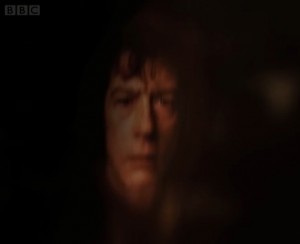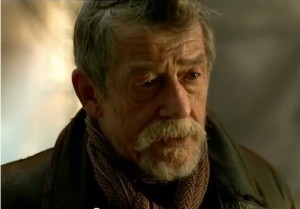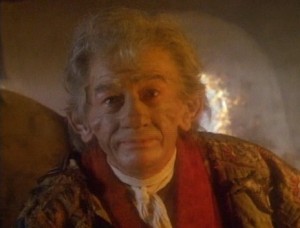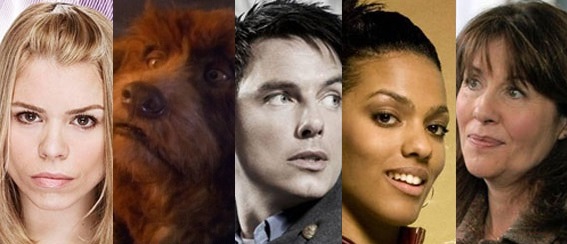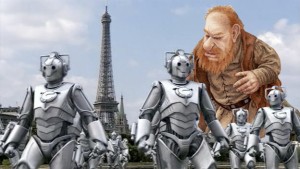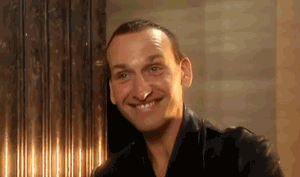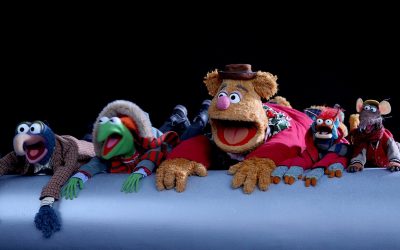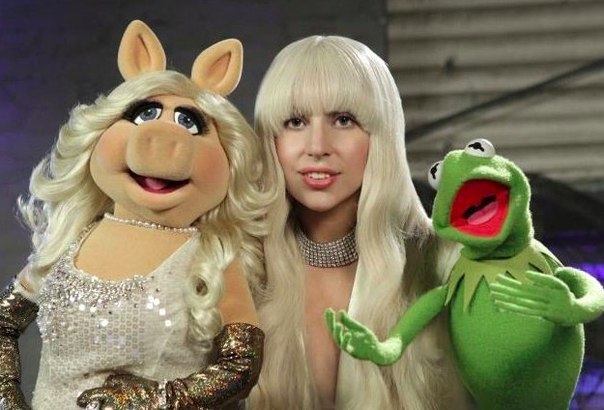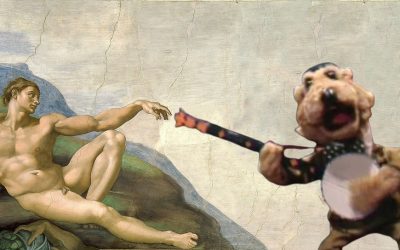Celebrating 50 years of Doctor Who!
(A word of warning before we begin. For the purposes of this article, I’m assuming that all Doctor Who fans in the audience have already seen both the season 7 finale “The Name of the Doctor,” and the mini-episode “The Night of the Doctor.” Spoilers for both of those things follow.)
(I’m also assuming that non-Doctor Who fans don’t care about any of that.)
At the end of Doctor Who season 7, we were introduced to a previously-unknown version of the title character. So far we don’t know very much about him – he fought in the Last Great Time War, he cast off the name the Doctor in favor of being a warrior, and he’s played by John Hurt. Most importantly, however, we know that he aged. The Doctor’s other eleven incarnations changed very little, even when they lived for hundreds of years. But the War Doctor’s appearance changed radically. When he first regenerated, he looked like this:
By the time he meets up with Doctors Ten and Eleven, he has aged into a person who looks like this:
Doctor Who head writer Steven Moffat is a man of big ideas, and I can’t imagine he would make the character age physically unless he has a good reason to do so. He could have introduced an already-aged John Hurt and no one would have complained. But he didn’t do that, and it’s very likely that we’re going to see the evolution from young Hurt to old Hurt in the 50th anniversary episode on Saturday, November 23. And that can only mean one thing.
You guessed it. We’re going to see an another, even older version who looks like this:
Yes, friends. At some point following the Last Great Time War, the Doctor/the War Doctor – tired from the fight – holed up in a creepy old mansion, lit a fire, and took on yet another name: THE STORYTELLER.
What evidence do we have?
1) We don’t know how old the Storyteller is, but he certainly appears to be quite elderly indeed. It’s a natural evolution from the young, handsome John Hurt to the older John Hurt to the weird-looking, giant-eared alien of the future. For all we know, this is what happens when Time Lords stay in one incarnation for too long (we already know that time-travelers’ facial features do get bigger as they age. Just ask the Face of Boe.) It’s been a secret clue for Doctor Who fans, just waiting in those Storyteller episodes this entire time.
2) Like the Doctor, the Storyteller has a companion. The Doctor’s is usually an attractive young human like Sarah Jane, Martha, or Captain Jack rather than a dog that sounds like Brian Henson, but they all serve the same function: At the most basic level, they give the lead character someone to talk to. They ask the questions that the audience would ask. But we also know from years of Doctor Who that his companions keep him functioning. They keep him from going too far. He’d go crazy if he was by himself, and the companions stop that from happening. And here, at the edge of the universe, the Dog does the same thing.
2a) This is not the first time the Doctor has traveled with a radio-controlled dog. Hopefully it won’t be the last either.
3) Both characters are fond of delivering long, passionate monologues. In both cases, these monologues are often simple plot exposition (after all, it has to go somewhere). But really, it’s more than that. It defines who they are as characters. The Doctor has delivered all manner of memorable speeches, from the heartfelt to the exhilarating. When the Doctor is moved to strong emotions of any kind, he talks. He talks a lot, and often very quickly. Similarly, if the Storyteller didn’t spend a lot of time talking, there would be no stories, and then we’d just be watching a sarcastic dog.
Honestly, though, the Storyteller’s use of language is what brings us into the stories. Often, the most exciting parts of any given episode are the sequences where it’s just John Hurt talking into the camera enthusiastically. Even when the special effects or some of the other performances aren’t up to par, the Storyteller’s eagerness to share always makes the show worth-watching. That’s the most Doctor-esque quality a character could possibly have.
4) There’s evidence of another regeneration – the fresher-faced, human-looking 2nd Storyteller, played by Michael Gambon. Until the Hurt version appeared, fans always assumed that the 8th Doctor (played by Paul McGann) turned directly into the 9th (played by Christopher Eccleston). Now we know that isn’t true. Moffat loves to mess around with fan expectations, so there’s no reason why there couldn’t be even more interim incarnations. Both incarnations of the Storyteller even had the same companion, providing stability for fans unfamiliar with the concept of regeneration.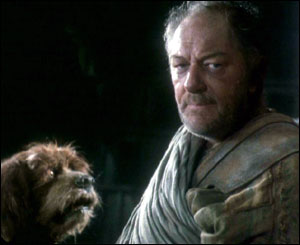
4a) Michael Gambon also played a different character on Doctor Who proper, which fits in with the show’s long tradition of casting actors in multiple roles. That’s true for the upcoming 12th Doctor, Peter Capaldi, so why not Doctor 8.5.1?
5) The Doctor has spent his life fighting monsters, and the Storyteller’s tales are full of them. Sure, they’re trolls and griffins instead of Daleks and Yetis, but they’re monsters just the same. He’s telling stories similar to the things he experienced while traveling. They take place in different times and different places, and they touch on a variety of genres (while staying in the general realm of fantasy rather than science fiction). The first line of The Storyteller‘s opening narration is “When people told themselves their past with stories,” and isn’t difficult to imagine that this a version of the Doctor who’s trying to sort through the terrible events of the Time War by telling monster stories with happier endings than the one he just lived through.
After all, what is a Cyberman but a Heartless Giant?
6) But even more than that, all of his stories are about the power of humanity. The Doctor loves humans. He’s on record as saying that humans are his favorite species. He loves their capacity for exploration, for growth, and for learning new things. He thinks they look like giants. Similarly, all of the Storyteller’s tales are of people in extraordinary circumstances. In the coldest and darkest years of his life, the former Doctor has lost his will to fight, and he’s reminding himself of his greatest love in the universe. People, clever people on Earth, doing whatever they need to do to survive – conquering fear, trapping death itself. These are stories of humanity struggling for something greater, and the Storyteller just can’t stop himself from repeating them. On one occasion, he even inserts himself into the narrative, perhaps because he’s so desperate to relive his days walking among the people of Earth.
Based on all of those facts, it seems clear to me that after his darkest point – fighting in the Last Great Time War, sacrificing his race for the good of the universe – the Doctor found catharsis by simply telling stories. That was his release. That’s how he worked through the anger, which allowed him to re-emerge as the happier, dancing 9th Doctor. It’s the only possible explanation.
Click here to time-travel back from after November 23 and tell me that I was right all along on the Tough Pigs Forum.
by Anthony Strand

